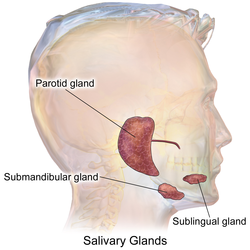Salivary glands
| Salivary gland | |
|---|---|

Human salivary glands.
|
|
| Details | |
| Identifiers | |
| Latin | Glandulae salivariae |
| Dorlands /Elsevier |
g_06/12391916 |
| FMA | 95971 |
|
Anatomical terminology
[]
|
|
The salivary glands in mammals are exocrine glands, glands with ducts, that produce saliva, which is formed of several things including amylase, a digestive enzyme that breaks down starch into maltose and glucose. In humans and some other mammals the secretion is alpha-amylase also known as ptyalin.
The salivary glands are detailed below:
The two parotid glands are major salivary glands wrapped around the mandibular ramus in humans. The largest of the salivary glands, they secrete saliva to facilitate mastication and swallowing, and amylase to begin the digestion of starches. It is the serous type of gland which secretes the ptyalin. It enters the oral cavity via the parotid duct or Stensen duct. The glands are located posterior to the mandibular ramus and anterior to the mastoid process of the temporal bone. They are clinically relevant in dissections of facial nerve branches while exposing the different lobes of it since any iatrogenic lesion will result in either loss of action or strength of muscles involved in facial expression. They produce 20% of the total salivary content in the oral cavity.
The submandibular glands are a pair of major salivary glands located beneath the lower jaws, superior to the digastric muscles. The secretion produced is a mixture of both serous fluid and mucus, and enters the oral cavity via the submandibular duct or Wharton duct. Approximately 65-70% of saliva in the oral cavity is produced by the submandibular glands, even though they are much smaller than the parotid glands.You can usually feel this gland, as it is in the superficial cervical region and feels like a rounded ball. It is located about two fingers above the Adam's apple (laryngeal prominence) and about two inches apart under the chin.
...
Wikipedia
